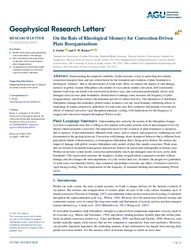On the Role of Rheological Memory for Convection‐Driven Plate Reorganizations
DOI: https://doi.org/10.1029/2022GL099574
Persistent URL: http://resolver.sub.uni-goettingen.de/purl?gldocs-11858/10351
Persistent URL: http://resolver.sub.uni-goettingen.de/purl?gldocs-11858/10351
Fuchs, L.; Becker, T. W., 2022: On the Role of Rheological Memory for Convection‐Driven Plate Reorganizations. In: Geophysical Research Letters, Band 49, 18, DOI: 10.1029/2022GL099574.
 |
Dokument öffnen: |
Understanding the temporal variability of plate tectonics is key to unraveling how mantle convection transports heat, and one critical factor for the formation and evolution of plate boundaries is rheological “memory,” that is, the persistence of weak zones. Here, we analyze the impact of such damage memory in global, oceanic‐lithosphere‐only models of visco‐plastic mantle convection. Self‐consistently‐formed weak zones are found to be reactivated in distinct ways, and convection preferentially selects such damaged zones for new plate boundaries. Reactivation of damage zones increases the frequency of plate reorganizations, and hence reduces the dominant periods of surface heat loss. The inheritance of distributed lithospheric damage thus dominates global surface dynamics over any local boundary stabilizing effects of weakening. In nature, progressive generation of weak zones may thus counteract and perhaps overcome any effects of reduced convective vigor throughout planetary cooling, with implications for the frequency of orogeny and convective transport throughout Wilson cycles. Plain Language Summary:
Understanding how and why the motion of the lithosphere changes over time is important since this is telling us how planets with a plate tectonic style of heat transport evolve by thermo‐chemical mantle convection. One important factor for the evolution of plate boundaries is hysteresis, that is, memory of past deformation. Inherited weak zones, such as sutures, and progressive weakening are well documented in the geological record. Convection with damage shows dynamical behavior that is different from pure plastic failure without memory, or homogenous lithosphere that is being newly broken. We analyze the impact of damage with global, oceanic‐lithosphere‐only models of plate‐like mantle convection. Weak zones that are formed in an initially homogenous material are found to be reactivated subsequently in distinct ways. Within our tectonic system model, convection preferentially selects pre‐damaged zones for new, active plate boundaries. This reactivation increases the frequency of plate reorganizations compared to models without damage, and also changes the time‐dependence of cyclic surface heat loss. In nature, the progressive generation of weak zones over planetary history may counteract and perhaps overcome any effects of reduced convective vigor during cooling. This has implications for the frequency of mountain building and understanding Wilson cycles. Key Points:
Results from global, plate‐generating convection models with damage.
Self‐consistently formed persistent weak zones lead to more frequent plate reorganizations.
Accumulation of weak zones might counteract decrease in convective vigor for tectonic variability.
Statistik:
ZugriffsstatistikSammlung:
- Geologie [933]
This is an open access article under the terms of the Creative Commons Attribution License, which permits use, distribution and reproduction in any medium, provided the original work is properly cited.

